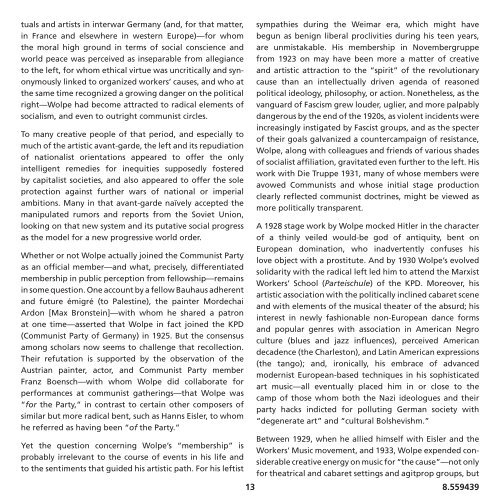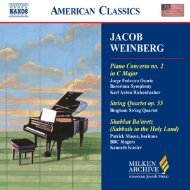Download Liner Notes PDF - Milken Archive of Jewish Music
Download Liner Notes PDF - Milken Archive of Jewish Music
Download Liner Notes PDF - Milken Archive of Jewish Music
You also want an ePaper? Increase the reach of your titles
YUMPU automatically turns print PDFs into web optimized ePapers that Google loves.
tuals and artists in interwar Germany (and, for that matter,in France and elsewhere in western Europe)—for whomthe moral high ground in terms <strong>of</strong> social conscience andworld peace was perceived as inseparable from allegianceto the left, for whom ethical virtue was uncritically and synonymouslylinked to organized workers’ causes, and who atthe same time recognized a growing danger on the politicalright—Wolpe had become attracted to radical elements <strong>of</strong>socialism, and even to outright communist circles.To many creative people <strong>of</strong> that period, and especially tomuch <strong>of</strong> the artistic avant-garde, the left and its repudiation<strong>of</strong> nationalist orientations appeared to <strong>of</strong>fer the onlyintelligent remedies for inequities supposedly fosteredby capitalist societies, and also appeared to <strong>of</strong>fer the soleprotection against further wars <strong>of</strong> national or imperialambitions. Many in that avant-garde naïvely accepted themanipulated rumors and reports from the Soviet Union,looking on that new system and its putative social progressas the model for a new progressive world order.Whether or not Wolpe actually joined the Communist Partyas an <strong>of</strong>ficial member—and what, precisely, differentiatedmembership in public perception from fellowship—remainsin some question. One account by a fellow Bauhaus adherentand future émigré (to Palestine), the painter MordechaiArdon [Max Bronstein]—with whom he shared a patronat one time—asserted that Wolpe in fact joined the KPD(Communist Party <strong>of</strong> Germany) in 1925. But the consensusamong scholars now seems to challenge that recollection.Their refutation is supported by the observation <strong>of</strong> theAustrian painter, actor, and Communist Party memberFranz Boensch—with whom Wolpe did collaborate forperformances at communist gatherings—that Wolpe was“for the Party,” in contrast to certain other composers <strong>of</strong>similar but more radical bent, such as Hanns Eisler, to whomhe referred as having been “<strong>of</strong> the Party.”Yet the question concerning Wolpe’s “membership” isprobably irrelevant to the course <strong>of</strong> events in his life andto the sentiments that guided his artistic path. For his leftistsympathies during the Weimar era, which might havebegun as benign liberal proclivities during his teen years,are unmistakable. His membership in Novembergruppefrom 1923 on may have been more a matter <strong>of</strong> creativeand artistic attraction to the “spirit” <strong>of</strong> the revolutionarycause than an intellectually driven agenda <strong>of</strong> reasonedpolitical ideology, philosophy, or action. Nonetheless, as thevanguard <strong>of</strong> Fascism grew louder, uglier, and more palpablydangerous by the end <strong>of</strong> the 1920s, as violent incidents wereincreasingly instigated by Fascist groups, and as the specter<strong>of</strong> their goals galvanized a countercampaign <strong>of</strong> resistance,Wolpe, along with colleagues and friends <strong>of</strong> various shades<strong>of</strong> socialist affiliation, gravitated even further to the left. Hiswork with Die Truppe 1931, many <strong>of</strong> whose members wereavowed Communists and whose initial stage productionclearly reflected communist doctrines, might be viewed asmore politically transparent.A 1928 stage work by Wolpe mocked Hitler in the character<strong>of</strong> a thinly veiled would-be god <strong>of</strong> antiquity, bent onEuropean domination, who inadvertently confuses hislove object with a prostitute. And by 1930 Wolpe’s evolvedsolidarity with the radical left led him to attend the MarxistWorkers’ School (Parteischule) <strong>of</strong> the KPD. Moreover, hisartistic association with the politically inclined cabaret sceneand with elements <strong>of</strong> the musical theater <strong>of</strong> the absurd; hisinterest in newly fashionable non-European dance formsand popular genres with association in American Negroculture (blues and jazz influences), perceived Americandecadence (the Charleston), and Latin American expressions(the tango); and, ironically, his embrace <strong>of</strong> advancedmodernist European-based techniques in his sophisticatedart music—all eventually placed him in or close to thecamp <strong>of</strong> those whom both the Nazi ideologues and theirparty hacks indicted for polluting German society with“degenerate art” and “cultural Bolshevishm.”Between 1929, when he allied himself with Eisler and theWorkers’ <strong>Music</strong> movement, and 1933, Wolpe expended considerablecreative energy on music for “the cause”—not onlyfor theatrical and cabaret settings and agitprop groups, but13 8.559439
















